
Frustrating, isn't it?
You spent all that time writing an article, but your visitors aren't reading the content. The traffic is there, but the time people spend on the page is awful. On the one hand, you know your content is valuable.
And on the other hand?
People aren't engaging with the content, and your conversions show it.
What's the deal?
Two words: Bucket brigades.
Or a lack thereof. Truth be told, people don't read every single word on the page.
They skim.
And when you break up the text with these “special phrases” known as bucket brigades, everything changes.
So if you want to learn how to use bucket brigades to captivate your audience and generate more leads and sales, you'll love this new post.
Keep reading.
What is a Bucket Brigade?

Before I explain what a bucket brigade has to do with your content, let me clear something up.
What are bucket brigades?
Back before hand-pumped fire engines were a thing, people would form an assembly line and pass buckets of water along a human chain.
This human chain kept the flow of water going enough to put out fires.
Hence the name bucket brigade.
You can picture it, can't you? A long chain of people passing 5 gallon buckets from one person to the next, chucking water onto the fire until it's nothing but a pile of wet ashes.
But wait…
What does this have to do with you and writing articles for your blog?
What Do Bucket Brigades Have to Do With Blog Copywriting?
Bucket brigades are used as a metaphor to describe a copywriting technique also known as “grease-slides.”
Grease-slides or bucket brigades are short phrases in copy used to keep people reading your content for longer.
Let me explain:
That last little phrase “let me explain” is a perfect example of a bucket brigade in copywriting. It acts as a greasy-slide to the next sentence.
Now, let's explore some reasons you would want to use them in your content writing.
3 Big Reasons Bloggers Use Bucket Brigades
There are many benefits of using bucket brigades in your writing. Here are just a few.
1. Keeps the reader engaged
Any strategy that keeps the reader reading is good.
Why?
Because every piece of content you publish should have a specific goal:
- To build trust with your wealth of knowledge
- Get more email subscribers
- To sell a product
- Get them to follow you on social media
And if your readers aren't engaged, the content you write won't have the chance it needs to reach your goals.
Bucket brigades can help with that, because they stop the reader in their tracks and get them thinking.
It makes them want to read the next sentence.
2. Boosts SEO
What happens when a person clicks on one of your articles from a Google search result and stays on your site?
It sends a positive signal to Google that your blog fulfilled the search query.
Now, if your article is getting more attention than websites that rank higher than you, what do you think will happen?
Your website will get a boost in rankings.
Yes, there are many ways to increase organic traffic, but this one is too easy to ignore.
Adding bucket brigades throughout your blog posts can have incredible results.
Brian Dean uses bucket brigades and reports an average time on-page for one of his articles:
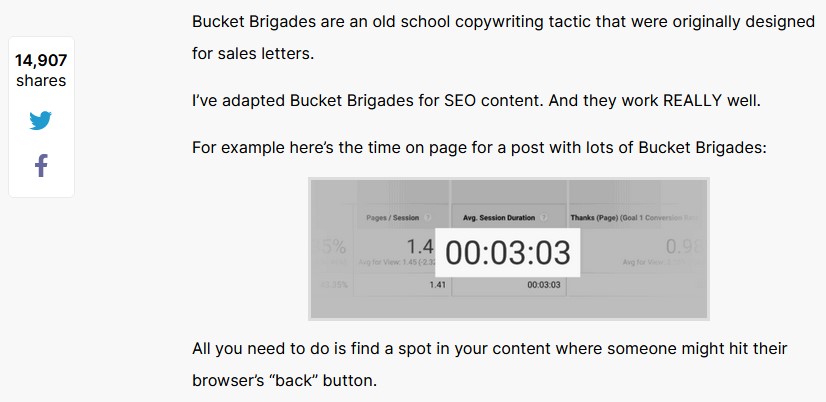
Over 3 minutes is impressive and will send all kinds of positive signals to Google.
3. Improves conversion rate
As I mentioned before, an engaged reader pays more attention.
And attention is essential to your bottom line.
You could have the best product in the world, but if your content doesn't hold attention, your conversions will suffer.
Even if your copy is great, your audience will leave if they lose interest.
Therefore, these simple phrases just might be what you need to keep them flowing to your call to action.
5 Bucket Brigade Examples
Want to see some examples of bucket brigades in action? Here are some of the best ones I found.
1. Ramsey Voice
Here's a great example of bucket brigades being used on a blog about singing better.
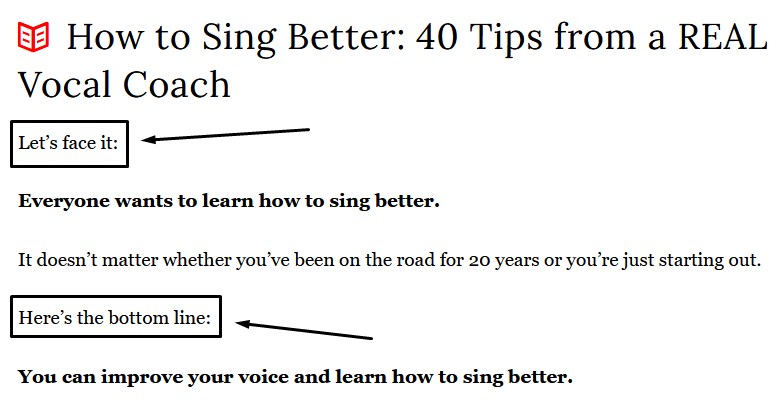
The writer starts the article with a phrase that provokes curiosity.
Let's face it:
When people read this, they can't help but read the next sentence. In their minds, they are asking, “let's face what? I need to know what I need to face!.”
And so they continue reading.
Then a couple of sentences later, you're hit with another bucket brigade.
Here's the bottom line:
This phrase is basically saying, here's what's important. It's not revealing what's important, you have to keep reading to find out.
It is building suspense, which makes the article more enjoyable to read.
Instead of reading the blog post for the sake of learning information, you're taken on an emotional journey.
2. Backlinko
Brian Dean is well known for using bucket brigades on his SEO blog, Backlinko.
He's the one who gets over a 3 minute average time on-page.
And here's how he does it:
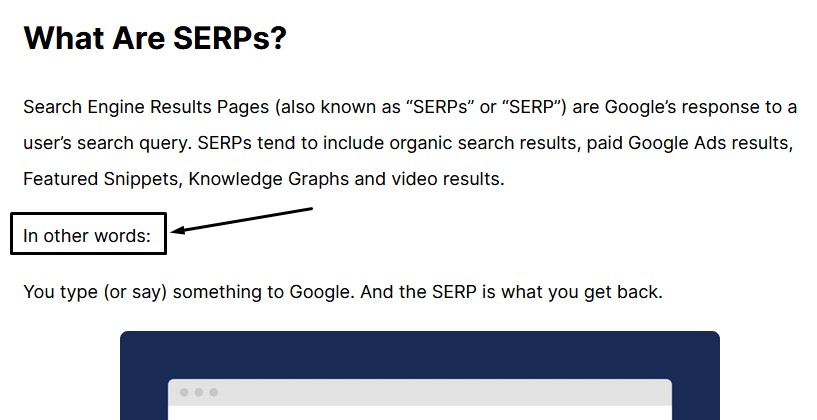
The phrase “in other words”, is a clever use of writing in this particular article. Because it follows an in-depth explanation of a complicated topic.
What are SERPs?
He's providing the reader with an easier way of understanding something, which will improve the experience and value of the article.
3. Jeff Bullas
Here's Jeff Bullas using a bucket brigade about how to write a blog intro.
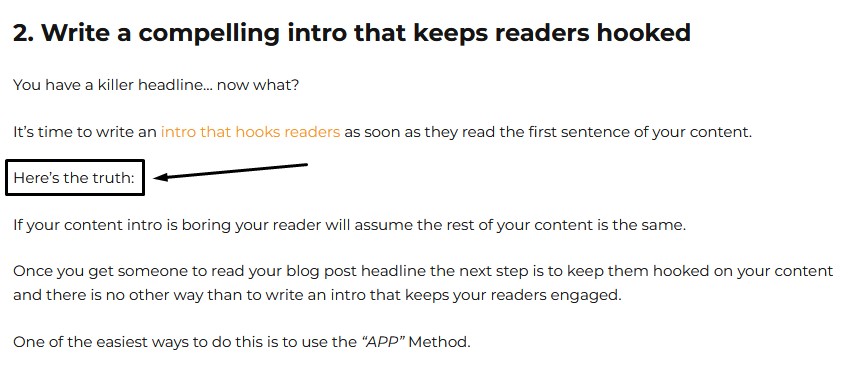
Before revealing the juice, he hits you with the phrase, “Here's the truth:”
Adding this phrase makes the answer seem more important, so you can't help but continue to read the post.
4. Ahrefs
Sometimes things need a further explanation.
But instead of bombarding readers with overwhelming details, break it down in bite-sized chunks.
That's what Ahrefs does in this example:
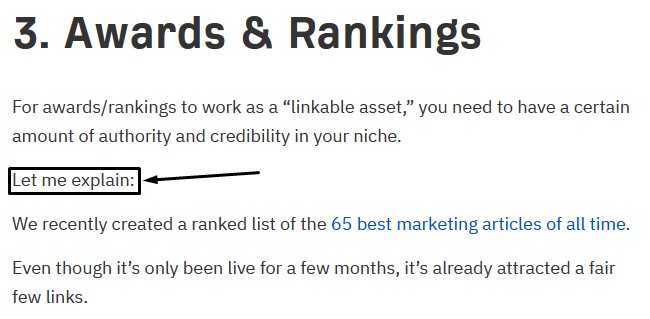
This praise “Let me explain:” is great for preparing someone for more information, without them losing interest.
5. Niche Pursuits
I couldn't resist not sharing one of our own articles here on Niche Pursuits.
I've been throwing them in my articles a lot recently. Like this one:
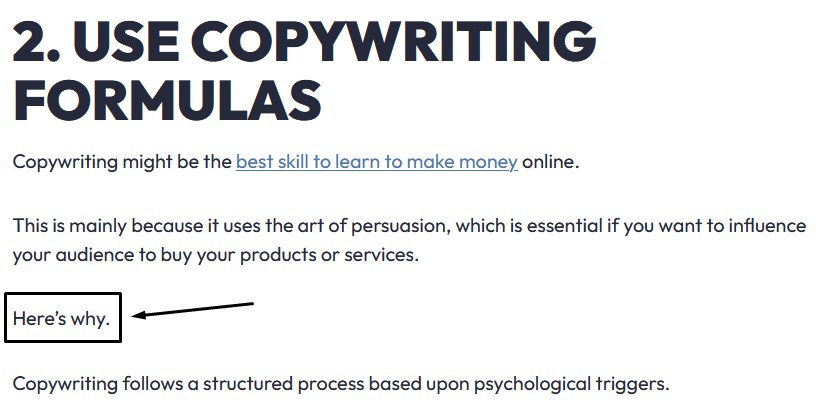
I use the phrase “Here's why” in my article copywriting for blogs. It's great for telling the reader exactly what they are going to read next.
And they will be more inclined to keep reading if they want to find out.
Where to Use Bucket Brigades in Your Blog Posts
The following are the places you want to use bucket brigades. Add them to your articles and see your engagement metrics improve.
Introduction
- Does this sound familiar?
- We've all done it.
Your blog post intro is the perfect place to use a bucket brigade.
Why?
Because when you do it right, they can't help but read more of your article.
So start your intros with a question or statement that requires them to keep reading to even understand what they read.
When explaining details
- Let me explain.
- Let's dig a little deeper.
These are great when needing to elaborate further, but letting them know what they're in for. It'll psychologically prepare them for it.
Transitioning to another perspective
- In other words…
- Here's another way to think about it…
These types of phrases get the reader to stop and think.
You've explained something, but you really want it to stick. So spin the idea in another perspective and hit them with one of the above just before it.
7 Bucket Brigades You Could Be Using
Here are 7 popular bucket brigades you can start using in your content marketing strategy from today.
- Here's the deal:
- Let me explain.
- Why?
- The question is:
- Let's dive right in.
- It's that simple.
- Here's how:
Strategically planting these throughout your blog posts will keep eyes on the page and your content more engaging.
Conclusion: Bucket Brigades
So there you have it. Bucket brigades are a super effective way to spruce up your articles.
It makes your writing more conversational and you build a better connection with your readers.
The best part?
Visitors stay on your blog for longer, you get more email subscribers, and convert more sales.
The post How to Use Bucket Brigades to Create Highly Engaging Content appeared first on Niche Pursuits.

